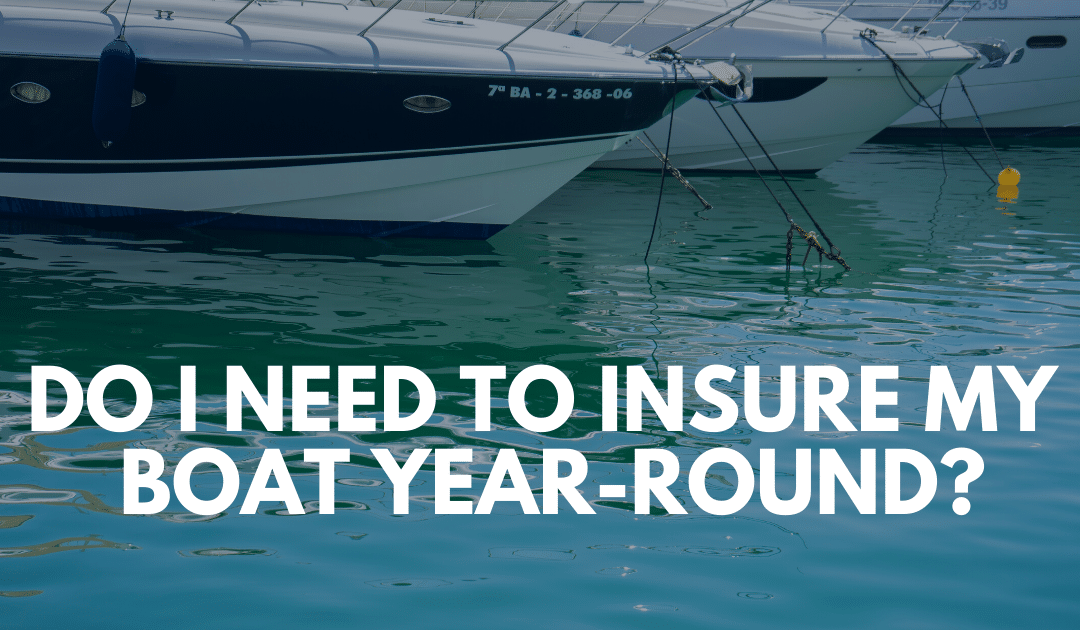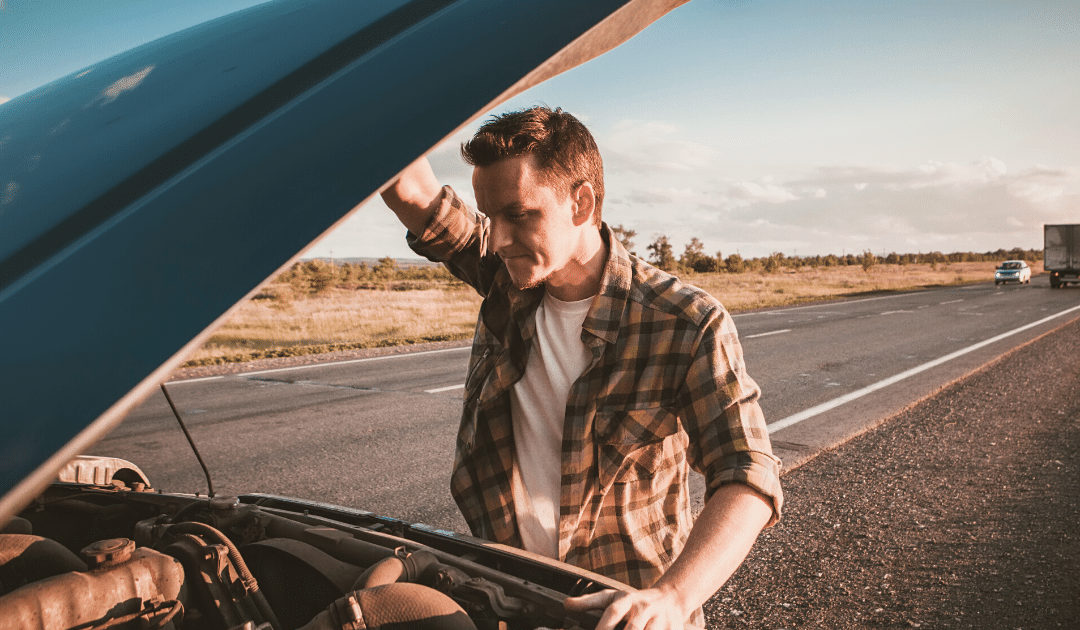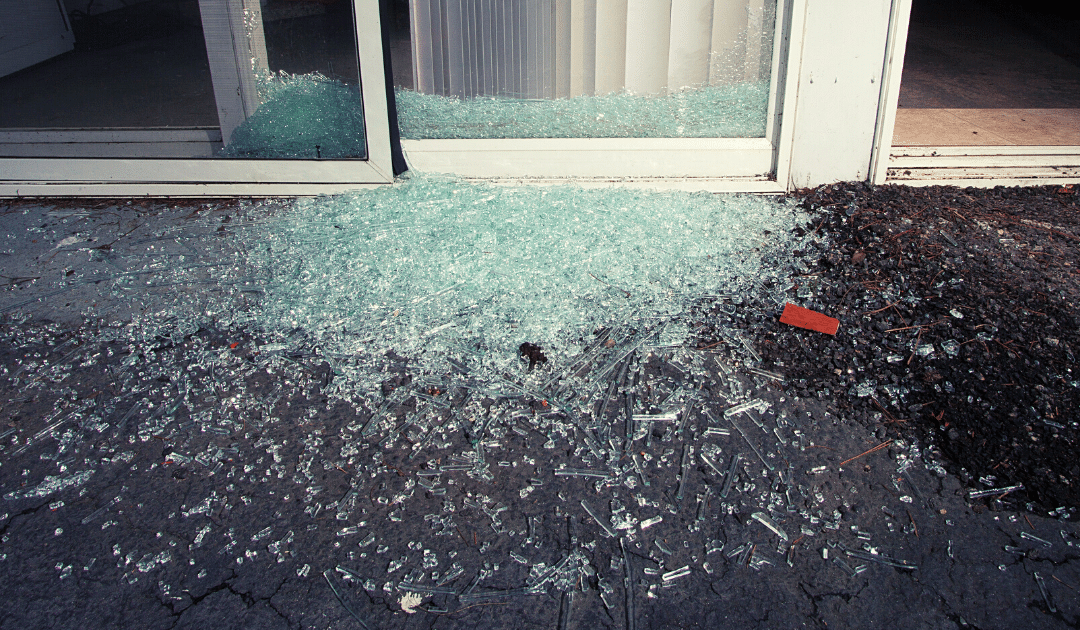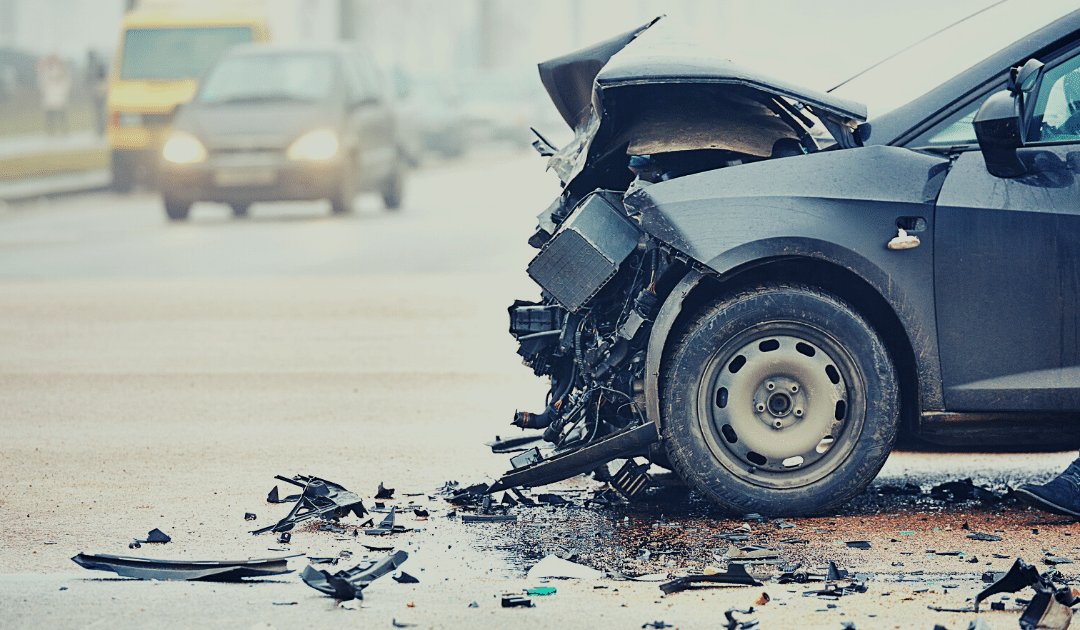
by California Casualty | Auto Insurance Info, Homeowners Insurance Info |
If you’re like most boat owners, you probably only use your boat a few months out of the year. And after all those summer trips are done, and your boat’s cleaned up and ready for storage, you might be tempted to cancel the insurance.
After all, if your boat won’t even be on the water, why would you need coverage?
Turns out, there are some compelling reasons to keep your insurance throughout the year, not the least of which is that it can actually save you money in the long run. Here are 4 top reasons.
1. Accidents Don’t Have an Offseason
More than half of the claims are filed for accidents that occur between September and January. The majority of those are for theft, vandalism, fire, and flooding. Boats are typically unattended during this time, which increases accident risk. When you carry boat insurance, these claims are covered by comprehensive coverage, costing far less than out-of-pocket payments would for repair and replacement in the event of an insurance lapse.
2. It May Be Required
If your boat is financed by a lender, you may be obligated to carry insurance year-round. Even if you own your boat outright, some marinas may require boats on the premises to be insured.
3. Don’t Count on Your Homeowner’s Policy
Many boat owners assume that damage to their boat is covered under their homeowner’s policy. Most times this isn’t the case, as the boat would probably only be protected if damage occurred while on the covered property. And even then, a homeowner’s policy might not fully cover the damage and/or leave the owner with coverage gaps (for example, many homeowners policies have length and horsepower limits that apply to boats). Boat insurance policies are crafted to meet specific needs and protect against risks inherent to boating.
4. It Makes Financial Sense
Depending on your insurer, signing up for a full 12-month policy can make you eligible for discounts or loyalty benefits, saving you money over the long term. Also keep in mind that many insurers already adjust the off-season monthly premiums to be lower than the on-season ones, so an annual policy, in the end, does offer better protection dollar for dollar than one for just several months. And don’t forget that as your boat ages you may find it more difficult to secure insurance if you cancel your policy. Finally, if you insure your boat with the same company as your car or homeowner’s insurance, you can most likely get a multiple policy discount.
Just as with homeowners and car insurance, a policy protecting your boat against damage and liability not only provides peace of mind but is a wise financial decision. And given the risks specific to boats, choosing a year-round policy is even smarter.
This article is furnished by California Casualty, providing auto and home insurance to educators, law enforcement officers, firefighters, and nurses. Get a quote at 1.866.704.8614 or www.calcas.com.

by California Casualty | Auto Insurance Info |
Routine keep up and maintenance will prevent breakdowns and help keep your car in good working condition for years, but when you put off signs of trouble or little things like appointments to get your oil changed, you risk a break down every time you get behind the wheel.
Not taking care of your vehicle can also cause major internal damage which could end up costing you thousands of dollars in repairs.
Yahoo has created a list based on a survey given to mechanics on The Ten Worst Things You Can Do to Your Car. Here were the results.
1. Putting off routine maintenance – This includes: checking your battery and brakes, aligning your tires, getting your oil changed, etc.
2. Ignoring the check engine light – The check engine light is the generic indicator that something is wrong with your vehicle and you should take it to a licensed mechanic.
3. Not changing the oil – When you don’t change your oil it can cause poor engine performance or even complete engine failure.
4. Failing to check tire pressure – Even with new tires, you will lose about one PSI every month. Poorly or overinflated tires could lead to a blowout and/or accident. You should continue to check and fill them monthly as needed.
5. Ignoring transmission, brake, coolant, and other fluid services – These fluids all play a part in making sure your vehicle is functioning properly.
6. Continuing to drive an overheated vehicle – This can easily lead to an engine fire and completely total your vehicle and/or cause series injuries to the driver.
7. Not changing fuel and air filters – Not changing these filters will degrade your vehicle’s performance and cause wear and tear on the engine.
8. Having someone unqualified service the vehicle – Don’t fall victim to cheap parts and faulty repairs. Look at reviews and make sure your mechanic or repair shop is properly licensed.
9. Using generic aftermarket parts and not manufacturer quality parts – When you use generic parts, you do not know if they have been properly inspected. This could lead to more issues in the future.
10. Trying to service your own vehicle – Although you may know how to do a few things yourself, when you take your vehicle to a professional, you can receive a full service and they will inspect and make sure everything in your vehicle is functioning properly and suggest needed maintenance/repairs.
Are you guilty of any? If so, it’s probably time to take your car to the mechanic before it’s too late.
Make sure your vehicle is covered, under the hood and on the road. Speak with a California Casualty representative today to review your auto policy so you can have peace of mind the next time you get behind the wheel. Click here or call 1.800.800.9410.
This article is furnished by California Casualty, providing auto and home insurance to educators, law enforcement officers, firefighters, and nurses. Get a quote at 1.866.704.8614 or www.calcas.com.

by California Casualty | Auto Insurance Info, Safety |
While there may be fewer people on the road these days, there is an increase in reckless and dangerous driving, resulting in more accidents — and sadly, fatalities.
Even for the best driver, intersections are some of the most dangerous places on the road. It’s really no surprise, though, given all the commotion concentrated in a small space: vehicles crossing each other’s paths, signals, signs, honking, merging lanes, pedestrians and bicyclists. Add in the all-too-common confusion many drivers experience around right-of-way, and you have a recipe for a fender bender or worse.
By brushing up on the traffic rules for intersections, you can feel more confident in safely maneuvering them. Here are some simple right-of-way reminders, listed by intersection type.
A Four-Way Stop
This is the most common type of intersection, where two roadways cross each other.
-
- Yield to drivers who’ve arrived before you. The first car to arrive always receives the right of way.
- If you arrive at the same time as another driver, the one who’s farthest to the right gets the right of way.
- If three vehicles arrive at the same time, the rule of “right-most has the right of way” still holds, and the car farthest left goes last.
Intersection Without a STOP or YIELD Sign
Known as an “uncontrolled” intersection due to lack of signs or signals, these often trip people up.
-
- Yield to drivers already in the intersection or those who’ve arrived before you.
- If you arrive at the same time as another, the right-most vehicle has the right of way.
A T-junction (Three-Way Intersection)
This is where a minor road dead-ends into a major roadway.
-
- Vehicles on the major road (the through road) always have the right of way.
- If you’re entering from the minor roadway, you must come to a complete stop and yield to drivers on the through road, no matter which way you’ll be turning.
A Traffic Circle
Also called a roundabout, this is an intersection of four or more roadways that converge into a single road that flows in one direction around a center island.
-
- When approaching the circle, always slow and yield to the vehicles in the traffic circle.
- Merge by turning right so that you’re driving around the circle in a counterclockwise direction.
- Turn right to exit the circle when you reach your roadway.
- Do not stop in the roundabout – a steady flow and speed is critical to safety.
U-Turns or Left Turns Onto Two-way Roads
-
- You’re basically last in line: Don’t turn until you yield to oncoming cars, motorcyclists, bicyclists, and pedestrians.
- Keep in mind that both of these turns carry extra risk, so remember safety first, always.
Besides employing the rules above, remember to always slow down and pay attention when approaching intersections. This is a winning combo for smoothly navigating any intersection and getting to where you’re going safely.
This article is furnished by California Casualty, providing auto and home insurance to educators, law enforcement officers, firefighters, and nurses. Get a quote at 1.866.704.8614 or www.calcas.com.

by California Casualty | Auto Insurance Info, Safety |
Late summer riding beckons; open roads, open skies, long days, and beautiful sunsets. The flipside? Extreme heat. And also a transition period of reacquainting yourself with the roads and traffic. Use these tips to keep your bike and yourself cool and safe.
For Your Bike
Keeping your ride cool and running smoothly through the summer usually entails a little extra maintenance. Here are some of the priority areas to fitness-check before setting out.
- Tires – Tire blowouts are usually caused by underinflated, rather than overinflated, tires. Make sure to inflate to the manufacturer’s recommended PSI. And remember that high external temps cause tire pressure to increase due to expanding gas. Check them each week and adjust as necessary. Also keep an eye on the tires’ condition, looking for any cracks, punctures, bulges, or worn tread.
- Fluids – Check oil, brake, coolant, hydraulic fluids, and their reservoirs for debris, condensation, and discoloration or changed consistency. Get them changed if they’re due. Check the water pump and hoses regularly for leaks, cracks, and tears. Pro tip: cover your radiator to keep the engine cool (and protect it from dirt, bugs and UV rays). On the hottest days, avoid stationary idling to prevent engine overheating.
- Gas tank – If your bike has been sitting all winter with fuel in the tank, it might not start up. Drain the tank — if there’s any brown grit in the fuel, your tank has probably rusted. You can take it to a mechanic or DIY by flushing with acid remover. After cleaning, treat the new gasoline with a fuel stabilizer.
- Electrical connections – If your electrical connections aren’t secure, the moisture from humid environments can short the connection and stop your bike from functioning. Inspect all wires and connections to components (including battery) and fasten any loose ones. If they’re corroded, it’s best to replace them.
For You
Riding in extreme heat can increase your chance of health risks, overheating, and accident risk. Follow these tips to stay safe and comfortable.
- Hydration – Staying hydrated is one of the best preventive measures for summer riding. Drink water at every stop and consider purchasing a CamelBak for extended rides. Avoid alcohol, as it can easily dehydrate you.
- Sun safety – Even if it’s overcast, you’re still getting hit by UV rays. Wear sunscreen and reapply to exposed skin as often as possible.
- Clothing – Safe riding means extra layers, even in the summer heat. Here are some hacks to keep you cool in your gear.
- Form-fitting sportswear can keep your body temperature down – look for moisture-wicking fabric.
- A lightweight base layer under your jacket and pants can prevent discomfort and keep you dry.
- When leather pants are too hot, check out specialized jeans that have Kevlar fabric lining and other safety components. Never wear shorts.
- Opt for ventilated summer-weight boots, which allow airflow to cool the feet and ankles.
- Mesh-backed gloves will let you grip the handles while allowing for ventilation – as well as hand protection in case of a fall or skid.
- There are options for jackets that protect while keeping you comfortable in the heat. Ventilated jackets with mesh panels allow for aeration, and many perforated leather jackets come with zip vents, which help you release body heat.
- A proper helmet – required by law in all but 3 states – is safety rule number one. Investing in a breathable, lightweight and ventilated helmet will keep your head (and by extension, your body) cool and protected. The best ones are usually carbon fiber.
Get Re-Accustomed to the Road
If you’ve been traveling mostly by car and are just getting back to the roads on 2 wheels, give yourself some time to re-adjust. You no longer have the wrap-around metal protection of a vehicle, and you may need to fine-tune your reaction time for sharing the road with cars.
Most motorcycle accidents are attributed to unsafe lane changes, car doors, speeding, sudden stops, left-turn accidents, and lane splitting, among others, so make sure you’re visible to the cars around you.
Finally, know the signs of heat stress (check out our article here). It can come on suddenly, so knowledge and prevention are your tools to stay cool and healthy.
This article is furnished by California Casualty, providing auto and home insurance to educators, law enforcement officers, firefighters, and nurses. Get a quote at 1.866.704.8614 or www.calcas.com.

by California Casualty | Auto Insurance Info, Homeowners Insurance Info |
While you’re finalizing your summertime plans for vacation, road trips, and or weekend getaways, thieves and burglars are just getting started on their busy season.
Read on to learn how to protect your home and car from break-ins this summer.
Home
Contrary to TV dramas, most burglaries take place during the day, between 10 am and 3 pm. They’re more frequent in the summer months than any other season, and the average dollar loss is around $2,000. The most commonly stolen items during a break-in include cash, jewelry, medications/drugs, guns, and electronics. Here are some ways to protect your home against intruders while you’re away.
- Make It Look Like Someone’s Home – Set interior lights on timers. Keep up your lawn/landscaping care schedule. Put a hold on newspaper and mail delivery. Close blinds in rooms where expensive items, such as TVs and other large electronics, might be visible.
- Don’t Share On Social Media – Resist putting your upcoming travel plans on social media. The same goes for voicemail, answering machines, and email autoreply. If you can’t help posting on social, keep the dates vague and make sure that your posts are only shared with (close) friends.
- Be Lock Savvy – Remove any spare keys on your property (burglars know where to look). Do a thorough check to make sure the locks work on all windows and doors — and make sure you lock everything before leaving. Finally, lock the garage as well as your car inside it!
- Tap Your Neighbors – Depending on how long you’ll be gone, consider asking a trusted neighbor or friend to check in on your home periodically. They can check for signs of attempted entry, landscaping issues, or other damage. Inside your home, they can adjust blinds and shift furniture a bit to convey human presence.
- Install an Alarm System – It may be worth getting an alarm system. Be sure to put alarm signs in the front and back yard (the latter is where most intruders enter premises). Make sure to let your alarm company know when you’ll be out of town, and that they have an updated list of contacts and numbers.
Auto
It’s time to hit the road — for road trips, weekend trips and day hikes. Here are 5 simple ways to reduce the risk of a break-in while you’re away from your car.
- Lock It – This goes without saying, but do make sure to lock all doors, including the trunk, and make sure all windows are rolled up. Sometimes key fobs misfire, so it’s best to do a manual check of your doors. If you’re traveling with kids, double-check their windows in case they rolled them down.
- Hide Valuables – If possible, leave nothing of value in the car anywhere. Any visible items — even loose change or phone charging cords — increases the risk of a break-in. If that’s not possible, bring what you can with you in a purse or day pack, and/or stow them away in your car (in the glove box, under a seat, stashed in the trunk, etc.). Make your car look as tidy and sparse as possible before locking and leaving it.
- Park Smart – Be aware of your chosen parking spot’s surroundings. Parking garages tend to be safest. On the street, avoid areas that have broken glass near the curb. Choose a spot near other parked cars, in a well-lit and busy area.
- Consider an Anti-Theft Device – If your car didn’t come with one, you may want to install an audible alarm system, which emits a loud noise when someone attempts to enter. Other devices include steering wheel locks (an old standby that’s very affordable), wheel locks, brake locks and tire locks. There are also higher-tech solutions such as GPS-enabled tracking systems.
- Take the Spare – Thieves know where to look for spare keys, so be sure to always take all keys with you.
Nothing ruins a summer adventure like a break-in. Taking some smart steps beforehand to protect your home and car will pay off with peace of mind and fond summer memories.
This article is furnished by California Casualty, providing auto and home insurance to educators, law enforcement officers, firefighters, and nurses. Get a quote at 1.866.704.8614 or www.calcas.com.

by California Casualty | Auto Insurance Info, Safety |
Less traffic has been hitting the roads, but cities and states across the country are actually seeing an increase in accidents- in adults and in teens. Fatal accidents involving teenagers has already hit an all-time high. Preliminary data from The National Safety Council indicates a 14% increase nationwide in fatal miles driven in the spring of 2020, compared to 2019.
While many people across the country stay inside and continue their “new normal” – working from home and only leaving the house when necessary, drivers on the less crowded roadways may be prone to take advantage of open lanes of traffic by driving recklessly, resulting in fatal accidents.
States all across the country have experienced increases in roadway deaths including California, Arkansas, Connecticut, Illinois, Louisiana, Nevada, New York, North Carolina, Oklahoma, Tennessee, and Texas.
If you have to get back on the road, follow these safety tips to avoid a deadly collision.
Brush Up on Traffic Rules & Regulations
It’s never a bad idea to re-familiarize yourself with traffic laws, especially if it’s been a while since you’ve been behind the wheel. Before you get back on the road, take some time to go over basic traffic rules and regulations for your state, and minimize the risk of getting in an accident.
Don’t Speed
Speeding is a bad habit that most of us are guilty of, and when traffic is light the urge to speed increases (especially on the interstate). Not only is speeding against the law, but it also makes the road extremely dangerous for everyone on it. Speeding alone causes over 100,000 deaths every year. With clear roadways during the pandemic, more drivers are speeding to get to their destination causing fatal accidents. Avoid injuring yourself and/or others, and don’t speed.
Drive Defensively
It’s more important than ever to stay alert and aware when you are on the road. Defensive driving is a set of driving skills that allow you to defend yourself against possible collisions caused by other drivers. These skills include: preparing to react to other drivers, avoiding distractions, and planning for the unexpected. You should always drive defensively, even if you are obeying all of the traffic laws, because other drivers may not be.
Watch Out For Pedestrians
In the early months of the pandemic, we saw more and more people turn to walking and biking for socially distant exercise, and many people have kept up with these healthy habits. When you are behind the wheel stay alert and keep an eye out for pedestrians that may be biking in streets or using crosswalks.
Educate Your Young Driver
Every May – September is considered the “100 Deadliest Days” for young drivers, as many hit the road for the first time (even during the pandemic). Teens are inexperienced behind the wheel, which makes them more susceptible to reckless and distracted driving – the number one killer of teens in America. Pair inexperience and reckless driving with an increase in fatal accidents and you have a recipe for disaster. Before your young driver gets behind the wheel this summer, educate them on following the rules of the road, even when there is no traffic. For more tips on teaching your teen driver click here.
Lastly, Make Sure You Have the Proper Coverage. Although this will not help you avoid a collision, it will save you time and money in the event you do get into an accident. While collision rates are on the rise, it’s important, now more than ever, to have the right auto insurance protection for when you get back on the road. This will not only help with out-of-pocket expenses due to an accident, but it will also give you peace of mind knowing that your insurance is one thing you don’t have to worry about during these trying and uncertain times.
Drive smart and stay safe. For more auto insurance tips click here.
This article is furnished by California Casualty, providing auto and home insurance to educators, law enforcement officers, firefighters, and nurses. Get a quote at 1.866.704.8614 or www.calcas.com.






